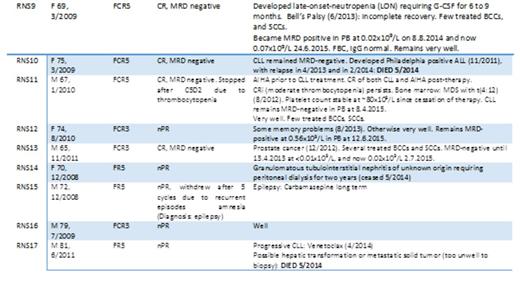Abstract
Background:
The ALLG CLL5 randomised dose de-escalation study examined the tolerability, safety and efficacy of oral FCR therapy as first-line treatment in fit elderly CLL patients (Mulligan, SP et al. iwCLL Abstract, 2015). The study incorporated an early stopping rule for prolonged grade 3/4 toxicity and documented the regimen to be safe, generally well tolerated, and highly effective. There is a relative paucity of published data on the long term outcomes of such patients, particularly in relation to the development of second malignancies as well as disease relapse rates, with its associated potential long-term complications. We aimed to review the long term outcomes in fit elderly patients that were recruited to ALLG CLL5 trial from Royal North Shore Hospital (RNSH) where 17 of the total cohort of 116 evaluable patients (15%) were recruited, treated and managed.
Methods:
The treatment schedule for the open-label, multi-centre, phase 2 ALLG CLL5 study has been described elsewhere, whereby fit (Cumulative Illness Rating Scale, CIRS ≤6) elderly (≥65 years) old patients, with previously untreated CLL were randomly assigned to receive one of three different chemoimmunotherapies: FR5, FCR3, FCR5 (Mulligan, SP et al. iwCLL Abstract, 2015). Treatment was repeated every 28 days with a planned total of 6 courses. A total of 116 eligible patients were recruited during the period of November 2008 and July 2012. After the completion of treatment, patients were followed every 3 months for 15 months. Ongoing review was subsequently at the treating physician's discretion. We reviewed the clinical progress from the hospital medical records of the 17 patients that were recruited from RNSH for this study.
Results:
Long-term follow up clinical data to cut-off date 3/7/2015 are described in the table below. Of this elderly CLL patient cohort of 17 patients, 5 have died (30%), the remainder (70%) are alive 4 to 7 years from therapy. About half (n=8) the cohort at this single hospital remain very well up to 7 years following FCR-based treatment, 2 with documented MRD-negativity, and 2 with a tiny small clone of >0.05x109/L.
CIRS Cumulative illness rating scale, CR complete remission, SD stable disease, nPR nodular partial remission, MRD minimal residual disease, IVIG intravenous immunoglobulin, C3 cycle3, C5D1 cycle 5 day1, C5D2 cycle 5 day2, IV intravenous, MDS myelodysplastic syndrome, NSCLC non-small cell lung cancer, AIHA autoimmune haemolytic anaemia, G-CSF granulocyte colony stimulating factors, ALL acute lymphoblastic leukemia, CRi complete remission with incomplete count recovery, BCC basal cell carcinoma, SCC squamous cell carcinoma, JC virus John Cunningham virus.
Conclusions:
Long-term outcome monitoring of patients on CLL trials, particularly the elderly, is becoming increasingly important as we attempt to understand the course of treating this disease with full dose or reduced-intensity chemoimmunotherapy, together with the development of other medical conditions that subsequently contribute to morbidity and mortality. Such monitoring has key implications in directing future management options in such an elderly cohort who are at increased risk of relapse, development of secondary cancers and cognitive decline. In this elderly patient cohort, half remain very well 4-7 years after therapy.
Mackinlay:Sanofi Aventis: Research Funding; Roche: Research Funding. Mulligan:Janssen: Consultancy, Honoraria, Speakers Bureau; Sanofi Aventis: Research Funding; Celgene: Consultancy, Honoraria; Roche: Consultancy, Honoraria, Research Funding, Speakers Bureau.
Author notes
Asterisk with author names denotes non-ASH members.



This feature is available to Subscribers Only
Sign In or Create an Account Close Modal